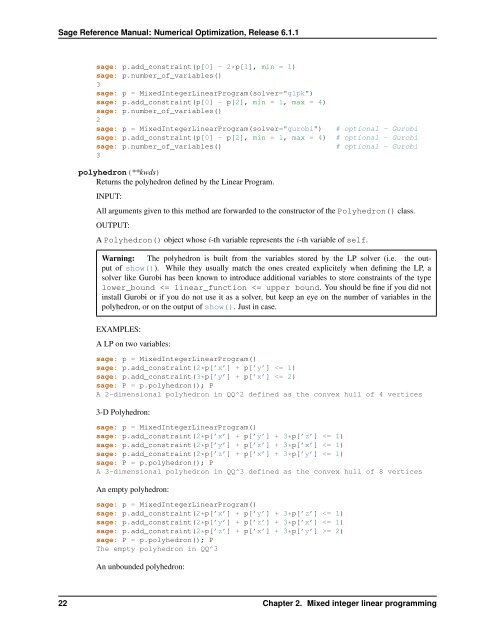Sage Reference Manual: Numerical Optimization - Mirrors
Sage Reference Manual: Numerical Optimization - Mirrors
Sage Reference Manual: Numerical Optimization - Mirrors
You also want an ePaper? Increase the reach of your titles
YUMPU automatically turns print PDFs into web optimized ePapers that Google loves.
<strong>Sage</strong> <strong>Reference</strong> <strong>Manual</strong>: <strong>Numerical</strong> <strong>Optimization</strong>, Release 6.1.1<br />
sage: p.add_constraint(p[0] - 2*p[1], min = 1)<br />
sage: p.number_of_variables()<br />
3<br />
sage: p = MixedIntegerLinearProgram(solver="glpk")<br />
sage: p.add_constraint(p[0] - p[2], min = 1, max = 4)<br />
sage: p.number_of_variables()<br />
2<br />
sage: p = MixedIntegerLinearProgram(solver="gurobi")<br />
sage: p.add_constraint(p[0] - p[2], min = 1, max = 4)<br />
sage: p.number_of_variables()<br />
3<br />
# optional - Gurobi<br />
# optional - Gurobi<br />
# optional - Gurobi<br />
polyhedron(**kwds)<br />
Returns the polyhedron defined by the Linear Program.<br />
INPUT:<br />
All arguments given to this method are forwarded to the constructor of the Polyhedron() class.<br />
OUTPUT:<br />
A Polyhedron() object whose i-th variable represents the i-th variable of self.<br />
Warning: The polyhedron is built from the variables stored by the LP solver (i.e. the output<br />
of show()). While they usually match the ones created explicitely when defining the LP, a<br />
solver like Gurobi has been known to introduce additional variables to store constraints of the type<br />
lower_bound
















